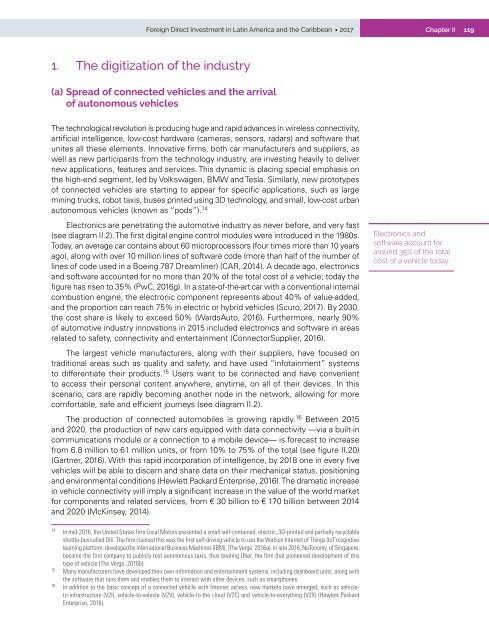Foreign Direct Investment in Latin America and the Caribbean 2017
This publication sets out and analyses the main foreign direct investment (FDI) trends in the countries of Latin America and the Caribbean. The 2017 edition shows that the region is at a difficult juncture. FDI inflows declined by 7.9% in 2016, to US$ 167.043 billion, representing a cumulative fall of 17.0% since the peak in 2011. The fall in commodity prices continues to affect investments in natural resources, sluggish economic growth in several countries has slowed the flow of market-seeking capital, and the global backdrop of technological sophistication and expansion of the digital economy has concentrated transnational investments in developed economies.
This publication sets out and analyses the main foreign direct investment (FDI) trends in the countries of Latin America and the Caribbean. The 2017 edition shows that the region is at a difficult juncture. FDI inflows declined by 7.9% in 2016, to US$ 167.043 billion, representing a cumulative fall of 17.0% since the peak in 2011. The fall in commodity prices continues to affect investments in natural resources, sluggish economic growth in several countries has slowed the flow of market-seeking capital, and the global backdrop of technological sophistication and expansion of the digital economy has concentrated transnational investments in developed economies.
Create successful ePaper yourself
Turn your PDF publications into a flip-book with our unique Google optimized e-Paper software.
<strong>Foreign</strong> <strong>Direct</strong> <strong>Investment</strong> <strong>in</strong> Lat<strong>in</strong> <strong>America</strong> <strong>and</strong> <strong>the</strong> <strong>Caribbean</strong> • <strong>2017</strong><br />
Chapter II<br />
119<br />
1. The digitization of <strong>the</strong> <strong>in</strong>dustry<br />
(a) Spread of connected vehicles <strong>and</strong> <strong>the</strong> arrival<br />
of autonomous vehicles<br />
The technological revolution is produc<strong>in</strong>g huge <strong>and</strong> rapid advances <strong>in</strong> wireless connectivity,<br />
artificial <strong>in</strong>telligence, low-cost hardware (cameras, sensors, radars) <strong>and</strong> software that<br />
unites all <strong>the</strong>se elements. Innovative firms, both car manufacturers <strong>and</strong> suppliers, as<br />
well as new participants from <strong>the</strong> technology <strong>in</strong>dustry, are <strong>in</strong>vest<strong>in</strong>g heavily to deliver<br />
new applications, features <strong>and</strong> services. This dynamic is plac<strong>in</strong>g special emphasis on<br />
<strong>the</strong> high-end segment, led by Volkswagen, BMW <strong>and</strong> Tesla. Similarly, new prototypes<br />
of connected vehicles are start<strong>in</strong>g to appear for specific applications, such as large<br />
m<strong>in</strong><strong>in</strong>g trucks, robot taxis, buses pr<strong>in</strong>ted us<strong>in</strong>g 3D technology, <strong>and</strong> small, low-cost urban<br />
autonomous vehicles (known as “pods”). 14<br />
Electronics are penetrat<strong>in</strong>g <strong>the</strong> automotive <strong>in</strong>dustry as never before, <strong>and</strong> very fast<br />
(see diagram II.2). The first digital eng<strong>in</strong>e control modules were <strong>in</strong>troduced <strong>in</strong> <strong>the</strong> 1980s.<br />
Today, an average car conta<strong>in</strong>s about 60 microprocessors (four times more than 10 years<br />
ago), along with over 10 million l<strong>in</strong>es of software code (more than half of <strong>the</strong> number of<br />
l<strong>in</strong>es of code used <strong>in</strong> a Boe<strong>in</strong>g 787 Dreaml<strong>in</strong>er) (CAR, 2014). A decade ago, electronics<br />
<strong>and</strong> software accounted for no more than 20% of <strong>the</strong> total cost of a vehicle; today <strong>the</strong><br />
figure has risen to 35% (PwC, 2016g). In a state-of-<strong>the</strong>-art car with a conventional <strong>in</strong>ternal<br />
combustion eng<strong>in</strong>e, <strong>the</strong> electronic component represents about 40% of value-added,<br />
<strong>and</strong> <strong>the</strong> proportion can reach 75% <strong>in</strong> electric or hybrid vehicles (Scuro, <strong>2017</strong>). By 2030,<br />
<strong>the</strong> cost share is likely to exceed 50% (WardsAuto, 2016). Fur<strong>the</strong>rmore, nearly 90%<br />
of automotive <strong>in</strong>dustry <strong>in</strong>novations <strong>in</strong> 2015 <strong>in</strong>cluded electronics <strong>and</strong> software <strong>in</strong> areas<br />
related to safety, connectivity <strong>and</strong> enterta<strong>in</strong>ment (ConnectorSupplier, 2016).<br />
The largest vehicle manufacturers, along with <strong>the</strong>ir suppliers, have focused on<br />
traditional areas such as quality <strong>and</strong> safety, <strong>and</strong> have used “<strong>in</strong>fota<strong>in</strong>ment” systems<br />
to differentiate <strong>the</strong>ir products. 15 Users want to be connected <strong>and</strong> have convenient<br />
to access <strong>the</strong>ir personal content anywhere, anytime, on all of <strong>the</strong>ir devices. In this<br />
scenario, cars are rapidly becom<strong>in</strong>g ano<strong>the</strong>r node <strong>in</strong> <strong>the</strong> network, allow<strong>in</strong>g for more<br />
comfortable, safe <strong>and</strong> efficient journeys (see diagram II.2).<br />
The production of connected automobiles is grow<strong>in</strong>g rapidly. 16 Between 2015<br />
<strong>and</strong> 2020, <strong>the</strong> production of new cars equipped with data connectivity —via a built-<strong>in</strong><br />
communications module or a connection to a mobile device— is forecast to <strong>in</strong>crease<br />
from 6.8 million to 61 million units, or from 10% to 75% of <strong>the</strong> total (see figure II.20)<br />
(Gartner, 2016). With this rapid <strong>in</strong>corporation of <strong>in</strong>telligence, by 2018 one <strong>in</strong> every five<br />
vehicles will be able to discern <strong>and</strong> share data on <strong>the</strong>ir mechanical status, position<strong>in</strong>g<br />
<strong>and</strong> environmental conditions (Hewlett Packard Enterprise, 2016). The dramatic <strong>in</strong>crease<br />
<strong>in</strong> vehicle connectivity will imply a significant <strong>in</strong>crease <strong>in</strong> <strong>the</strong> value of <strong>the</strong> world market<br />
for components <strong>and</strong> related services, from € 30 billion to € 170 billion between 2014<br />
<strong>and</strong> 2020 (McK<strong>in</strong>sey, 2014).<br />
Electronics <strong>and</strong><br />
software account for<br />
around 35% of <strong>the</strong> total<br />
cost of a vehicle today.<br />
14<br />
In mid-2016, <strong>the</strong> United States firm Local Motors presented a small self-conta<strong>in</strong>ed, electric, 3D-pr<strong>in</strong>ted <strong>and</strong> partially recyclable<br />
shuttle-bus called Olli. The firm claimed this was <strong>the</strong> first self-driv<strong>in</strong>g vehicle to use <strong>the</strong> Watson Internet of Th<strong>in</strong>gs (IoT) cognitive<br />
learn<strong>in</strong>g platform, developed by International Bus<strong>in</strong>ess Mach<strong>in</strong>es (IBM), (The Verge, 2016a). In late 2016, NuTonomy, of S<strong>in</strong>gapore,<br />
became <strong>the</strong> first company to publicly test autonomous taxis, thus beat<strong>in</strong>g Uber, <strong>the</strong> firm that pioneered development of this<br />
type of vehicle (The Verge, 2016b).<br />
15<br />
Many manufacturers have developed <strong>the</strong>ir own <strong>in</strong>formation <strong>and</strong> enterta<strong>in</strong>ment systems, <strong>in</strong>clud<strong>in</strong>g dashboard units, along with<br />
<strong>the</strong> software that runs <strong>the</strong>m <strong>and</strong> enables <strong>the</strong>m to <strong>in</strong>teract with o<strong>the</strong>r devices, such as smartphones.<br />
16<br />
In addition to <strong>the</strong> basic concept of a connected vehicle with Internet access, new markets have emerged, such as vehicleto-<strong>in</strong>frastructure<br />
(V2I), vehicle-to-vehicle (V2V), vehicle-to-<strong>the</strong> cloud (V2C) <strong>and</strong> vehicle-to-everyth<strong>in</strong>g (V2X) (Hewlett Packard<br />
Enterprise, 2016).


















